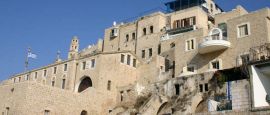Charting 3,000 years of culture, the Eretz Israel Museum is a sprawling museum in the Ramat Aviv district showing everything from Jewish ceremonial art to a reconstructed flourmill. Many artefacts on show were found on this very site, and are today displayed in a dozen separate pavilions.
Things to see in Tel Aviv
Tourist offices
Address: 46 Herbert Samuel Street, Marina, Tel Aviv, Israel
Tel: +972 3 516 6188.
Opening Hours:
Sun-Thu 0930-1830, Fri 0900-1400 (Apr-Oct); Sun-Thurs 0930-1730, Fri 0900-1300 (Nov-Mar).
www.visit-tel-aviv.comThe tourism association is a good place to go if you’re after leaflets and inspiration. The staff will happily point you towards the best things to do and can help with booking shows, hotels and restaurants as well.
The Tel Aviv City Break Booklet (www.visit-tel-aviv.com/en/Tel-Aviv-City-Break) is a free booklet of discount vouchers for numerous museums, attractions, entertainment venues, restaurants and shops within the city. You should download it online and have it stamped by your hotel at check-in. It must be validated on its first use.
One of Tel Aviv's oldest buildings, Independence Hall was where the State of Israel was signed into being on 14 May 1948. Now a museum, it recalls the events that led to that day and offers a stirring history of Zionism. Among its displays are several fascinating photographs showing barren sand dunes being awarded to Jewish settlers and the United Nations voting to partition Palestine.
Although it’s mentioned in the Bible, today’s Jaffa was mainly built in the 19th century following a destructive raid by Napoleon. The Ottoman Clock Tower, a focal point for outdoor socialising, marks the entrance to the Old Town, while other notable attractions include the Mahmoudiya Mosque and Kedumim Square, which is dominated by St Peter's Monastery.
This promenade runs along the Mediterranean coastline in Tel Aviv with clean sandy beaches on one side and skyscrapers on the other. The broadwalk is lined with street musicians, artists, plenty of shops and eateries which make for an enjoyable stroll any time of the year.
This world-class museum has been Israel's principal showcase for modern art since the 1930s. Originally housed in the home of the city's first mayor, today it occupies several buildings and a sculpture garden. The permanent collection includes works by Cézanne, Monet, Dali and Chagall, among others.
This is the place to learn about Tel Aviv's remarkable history from a sandy shore with a few huts to now a global city. Originally built as the Town Hall in 1924, it has been lovingly restored and now a key landmark. As part of The White City of Tel Aviv, it was recognized by UNESCO as a World Heritage Site in 2003.
The Museum of the Jewish People is devoted to Jewish history, migration and cultural diversity. It starts in 70 CE and runs all the way up to the modern day. Spread over six floors, it also includes a fascinating section on music featuring the rousing songs of Zionist pioneers.
This bohemian neighbourhood hosts a plethora of design shops, fashion boutiques and trendy bistros and restaurants. It’s also Tel Aviv’s cultural district home to institutions like the Frederic Mann Auditorium, Helena Rubinstein Art Museum and Israel’s famous Habima Theater.
For a phenomenal view over Tel Aviv, take the high-speed lift to the 49th floor observatory of the Azrieli Center. On a clear day, it is possible to see Jerusalem in one direction and Haifa in another. It also houses a huge shopping mall and a cinema with eight screens.
This museum tracks Israel’s struggles and wars through the Haganah, the Zionist defence militia that became the Israel Defence Force. Located in the former home of Eliyahu Golomb, one of the Haganah founders, it uses multimedia to follow Itzik, a fictional character who moves from a European ghetto to Palestine, eventually becoming an Israeli hero.
This historic train station, which was once a stop on the route between Jaffa to Jerusalem, has been completely renovated since going out of service. Today it houses a mixture of shops, restaurants and exhibition spaces, many of which stay open well into the evening. Expect to see some lovingly restored railway carriages too.
Founded in 1959, the Helena Rubinstein Pavilion forms part of a cultural complex that is home to the renowned Habima Theater and Bronfman Auditorium. One of the best places to see contemporary art in the city, the focus here is on local talent, though the upper floor also has an impressive collection of Meissen china.
Closed in 1965 after business was transferred to Ashdod further up the coast, Old Tel Aviv Port is now a post-industrial paradise packed with cool bars and restaurants, as well as an excellent market. The latter is distinctly artisan in style (and expensive as a result), but still a fascinating place for a wander.
A fun experience for young and old just outside Tel Aviv, this Zoological Center is home to the largest collection of wildlife in the Middle East that's under human care. Observe lions, hippos and white rhinos up-close from the comfort of your car as you drive through an African safari area. The comploex also includes a modern outdoor zoo.
Do you have any Feedback about this page?
© 2025 Columbus Travel Media Ltd. All rights reserved. No part of this site may be reproduced without our written permission, click here for information on Columbus Content Solutions.








 You know where
You know where